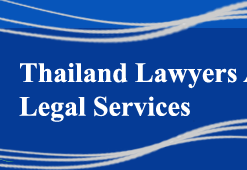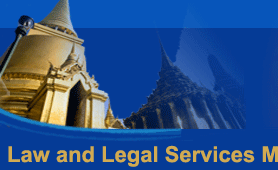



    |
||
| |
||
Articles
Legal News
Thailand Lawyer
Links
Home
Private Use on Musical Works, Rights of Public
Performance, and Collecting Society Systems.
By' Judge Visit Sripibool
rate).
OR at the option of the license holder:
Basis II:
4.5% of the annual gross takings from or in connection with all activities
conducted at the establishment, being the sums paid by customers as referred to
under Basis I above.
Commercial dance halls
As the basis set out for commercial discos, but with the substitution of the
following rates of royalty: in Basis I -4% for 6% and 2% for 3%; in Basis II -3%
for 4.5%.The PRS also proposed that the prompt payment discount in tariff D should be abolished, and its view was that the structure and basis of the tariff had become inappropriate in the light of modern developments and that the rates provided by it were unreasonably low.
on the whole range of services provided for the profit to the disco, including the supply of food and drink.
In its answer to the PRS statement of case, BEDA had opposed a fee fixed as a percentage of takings and urged that the tariff price should be fixed by a formula based on actual music use while also having regard to the audience dancing and listening to the music. It had proposed that a fair and reasonable formula for each establishment licensed under this tariff would be UK$ 18 for each 1,000 persons (or part thereof) admitted during the relevant year (plus VAT) and annually adjusted for changes in the Retail Prices Index (RPI). In its final submissions at the hearing it had urged that the appropriate figure fell in the range between UK$18 and UK$50 for each such 1,000 persons.
The evidence suggested that there might be about 600 commercial discos in the UK at present, some licensed by the PRS under tariff D and others under tariff J(as clubs) and some other tariffs. BEDA had 57 members who conducted about 257 discos. It represented mainly the larger discos and the larger disco operators and two of its largest members were estimated to have paid between them 78% of the tariff D revenue for 1986. Not all discos and disco operators were represented in this reference and BEDA's contentions might not have been known to all its members or generally among disco operators.
With the knowledge and approval of the parties, members of the Tribunal had paid visits to a number of discos and, considering all the material put forward in the course of the hearing, had found that discos were very different from the commercial dance halls before the Tribunal in 1959. The ballroom dancing of that time had been succeeded by a radically different dancing style, the disco had a relatively small dancing area and dancing was not necessarily the principal activity. Live music had been replaced by continuous recorded music 'most expertly reproduced'. A luxurious ambience had in many cases been created by very substantial expenditure on premises, equipment and furnishings. The sale of food and drink (sometimes at higher prices) was an essential ingredient-on average something like two thirds of the discos' turnover was from this source. The premises has drinks licences enabling discos to maintain or increase their clientele late at night and into the early morning. In short, the characteristics had changed so completely that in its present form tariff D was clearly not appropriate for discos. The contention of PRS was that popular music was used to attract customers to spend money
The Tribunal noted that in 1959 the Tribunal seemed to have adopted a percentage of admission receipts (whether actual or derived from a formula) largely because that formula had been agreed only 8 or 9 years earlier. It had been the intention both of the parties in agreeing upon that formula in 1949 and of the Tribunal in 1959 that the receipts calculated by the formula would approximate closely to actual gross receipts from admissions. However, the evidence suggested that the formula on which Basis A was found did not now accurately reflect the numbers of people attending contemporary discos.
The Tribunal accepted the view of the PRS that tariffs should draw the most appropriate balance, according to circumstances, between fairness and practicality. It was not unmindful of PRS' s views that the tariff should reflect the value of the licence to the licensee and also take account of the nature, extent and type of use made of the copyright music involved; the importance accorded by the public to music of the type used and the attractiveness of that music to them; the opportunities that users of such music were afforded by the availability to them of it for running successful enterprises, and the rates of royalty obtaining for comparable uses, particularly rates that had been recently negotiated.
BEDA has submitted that the size of the audience was the beat way of gauging what use was made of the music by the operators. The evidence was, that broadly speaking, all over the country discos were playing the same music for the same number of hours per session. Almost all the music played was from records and much of the success of a disco depended on the skilled choice and mixture of music played by the disc jockeys employed by the operators.
Most people attending discos were young and the Tribunal had been told that 'the d?cor and quality of the furnishings play a vital role in creating an atmosphere in which the young women feel more glamorous than usual and the young men more sophisticate and assured…music and dancing will always be a vital part of the mix but the key is to create a mini world ambience far removed from that of their everyday life. The element of fantasy is vital'.
The cost of fitting out a disco could range from UK$50 to over UK$80 per square foot and would be written off over five years. BEDA had placed before the Tribunal financial material derived from the 1987 management accounts of 52 of the discos run by three of its largest members. The filling-out cost of a disco with the capacity of 1,000 could be UK$750,000 and spread over five years that would be equivalent to UK$1.15 per admission per day. There was evidence to suggest that some discos were very profitable, some less so and some incurred a loss, but the Tribunal had no evidence at all about the large majority of discos.
In this outstanding case, the Tribunal considered that there were at least five possible bases on which a new tariff D license fee could be calculated, as follows:1 A uniform fee per license. Mainly because of local differences in the levels of disposable income and unemployment and in the availability of other forms of entertainment and recreation facilities, the Tribunal considered that a uniform fee would be unfair as between discos and for that reason it was rejected.
2 A fee based on all receipts. The PRS had drawn the Tribunal's attention to a decision about discos in a French Court of Appeal in which the Court had said that it was the performance of musical works which was the essence of the activity of the establishments in question and a close causal relationship existed between the diffusion of music and the receipts of the establishment, which constituted the product deriving from the exploitation of the woks diffused. It would not be reasonable to calculate the licence fee as a proportion of receipts or turnover.
3 A fee based on admission receipts. Many of the same arguments would apply here. The evidence suggested that about one third of total receipts came from admissions and all of a disco's receipts were inextricably connected. A fee based on receipts from admissions alone would be unfair to the PRS and provide an incentive to reduce admission charges and charge more for food and drink (though the scope for that might be limited). The Tribunal decided it would not be reasonable to fix the fee as a proportion of admission receipts.
4 A fee based on profits. Superficially a fee on this basis might seem to have advantage over (2) and (3) above in taking more account of ability to pay, but considerations similar to those applying to a fee based on all receipts led the Tribunal to reject a fee based on profits.
5 A fee based on the number of persons admitted. The view of the PRS was that where there were no ascertainable related takings the value of the license was best measured by assessing 'the scale of music use' by the licensee. BEDA had contended that the number of persons admitted was the best means of gauging the extent of the use of PRS music by disco operators. In these hypothetical circumstances a fee based on the number of admissions would also approximate to a fixed proportion of box office receipts, reflecting the Tribunal's view the
PRS's concept of ascertainable related takings could not be applied to discos and another basis must be used.In the light of the foregoing the Tribunal fixed the royalty at UK$45.50 (exclusive of VAT) per 1,000 or part of a 1,000 persons admitted, adjusted to take account of changes in the RPI (the Retail Prices Index) with effect from 1 August 1989. This rate was to apply also to commercial dance halls of which there now seemed to be very few. The Tribunal ordered PRS to pay costs of all of hearing for BEDA. Later, the PRS appealed to the High Court on a point of law (under Section 152(1) of the Copyright, Designs and Patent Act 1988, parties can appeal directly to the High Court only on a point of law) the High Court affirmed. The appeal was dismissed.
However, In the United Kingdom, the Copyright Tribunal is the body charged under the Copyright, Designs and Patents Act 1988 with resolving disputes in the wide variety of circumstances in which it has been given jurisdiction. The disputes arise between copyright owner and copyright user and invariably involve as a central issue the financial terms on which a right which is part of the copyright in a work may be exploited. Most, although not al, of the Tribunal's jurisdictions are based on the fact that the owner's right in being exercised by a collecting society.(287) In the Act, there is little general guidance to how the Tribunal is to approach its task, other than that it is to have regard to all relevant considerations and is to exercise its powers so as to secure that there is no unreasonable discrimination between licensees. The Tribunal has repeatedly stated that it is not confined to the proposals of the parties; it has a statutory duty to determine terms which are reasonable in all the circumstances, reasonable in this context meaning what is reasonable to both parties. Consequently, it is generally considered that the reasoning behind on the circumstances of the particular case and is independent of any other. However, one of the frequently recurring issues raised in proceedings before the Tribunal is the extent to which the royalty to be paid for the use of the right should be based on the revenue earned by the user. In this respect, at least, by examining a few recent decisions it may be possible to discern a common thread.(288)
There are interesting recent decisions. In AEI Rediffusion Music Limited v. Phonographic Performance Limited,(289) AEI Rediffusion Music Limited ('AEI') exercised its right to a statutory licence under Section 135A of the Act to broadcast the sound recordings in Phonographic Performance Limited's (PPL) repertoire via satellite to AEI's subscribers for them to play the recordings on public. AEI argued that its licence should be treated as comparable to the licence in issue in the decision of AIRC v. PPL,(290) in that the AEI service is similar to a commercial radio service and that therefore AEI should pay 5 percent of the music revenue, or UK$1.25 per United Kingdom site per month and as little as 13.5 pence for some overseas sites. PPL argued that the closest comparable was the licence that it granted to commercial dubbers who produce tapes and CDs of such recordings for hire to their subscribers for public performance by the subscribers, and that therefore the royalty should be 15 per cent of the revenue derived from music fees, equipment (sale/rental) and messaging or UK$12.50 per site per month, whichever was the greater. The Tribunal rejected the AEI argument that the AIRC comparable was appropriate and accepted that the commercial dubbing licendes provided a suitable comparable. The Tribunal set a royalty at whichever was the greater of 15 percent of the gross music revenue, but excluding messaging and equipment (sales/rental), or UK$5 per site per month. In British Sky Broadcasting Limited and Sky Television Plc. v. The Performing Right Society Limited,(291) British Sky Broadcasting Limited and Sky Television Plc ('Sky') wanted to alter the terms of its existing license to broadcast musical works as part of its television broadcasts. Sky argued that the royalty should be based on its share of viewing. PRS maintained that the royalty should be based on a percentage of Sky's revenue. The Tribunal rejected the revenue basis, stating that the revenue basis could only be used if there were sufficient nexus between the use of the music and the earning of the revenue, which it held was not so in that case. The Tribunal concluded that the royalty should be based on Sky's audienc
_____________________________________________________________________________________________________________________
(287) That is, in the terminology of the Act, a licensing body.
(288) Jonathan E. Rayner James Q.C., Andrew Norris, A Common Thread in Collective Copyright Licensing?, Entertainment Law Review vol.9 1998. London Sweet & Maxwell, 1998 at 205-207.
(289) [1998] R.P.C. 335.
(290) [1994] R.P.C. 143.
(291) Interim Decision, December 3, 1997.